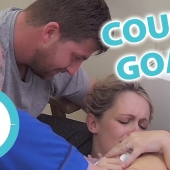There are various pain relief options but it is advisable to choose the one that is best for you, that will help you to cope with the pain and meet your needs.
There are many options: You can start with nothing at all, just breathing, you can also try water, that’s in a pool or a bath, there’s also gas and air – also called entonox – there’s drugs such as pethedine, diamorphine, epidural and there are alternative therapies.
The pros of a birth pool: It helps you because it soothes the pain, it helps you to be more relaxed, it keeps you calm, you can also go into many different positions while you’re in the water and also evidence has shown that if you use water you are less likely to have interventions or require any drugs. The downside of the birthing pool is if you go into the birthing pool too early it will not be as effective and it may slow down your labour.
Gas and air is a combination of oxygen and nitrous oxide and you can use it either through a face mask or a mouthpiece. It works very quickly to reduce the pain but it doesn’t take the pain away completely.
A TENS machine is a form of pain relief and this is applied through pads that are placed on your back. Electrical currents are produced, which numbs the pain signals so you don’t feel the pains. You are in control, you press when you need it. It’s quite useful when you’re in early labour but when pushing it’s not that effective.
The potential drugs that you can use during labour are pethedine, and diamorphine. This is an injection which is given and the benefits of pethedine or diamorphine is that it helps to keep you relaxed, it takes away most of the pain, and helps you to cope better as you have the contractions. It can take 20 minutes for the drugs to be effective and it can last for 2-4 hours depending on how much of it you’ve had.
An epidural is another form of pain relief and it is administered as an injection in the space outside of your spine. It helps because it numbs the nerve endings so you don’t feel the contractions as pain. Because you can’t feel the contractions it may slow down your labour, you may not know when you’re ready to push, and you may increase your chances of having an assisted birth.
You can discuss this with your midwife or your doctor. It’s also quite useful if you could attend antenatal classes, because it will help you to be prepared for when you actually go into labour.
- 3671 views













